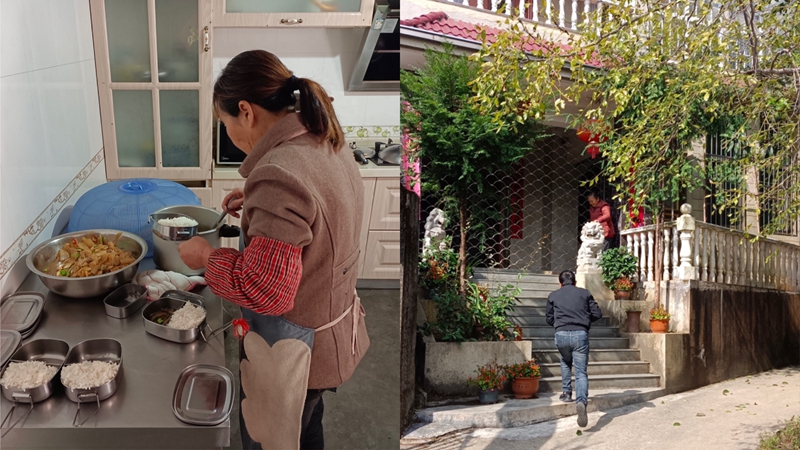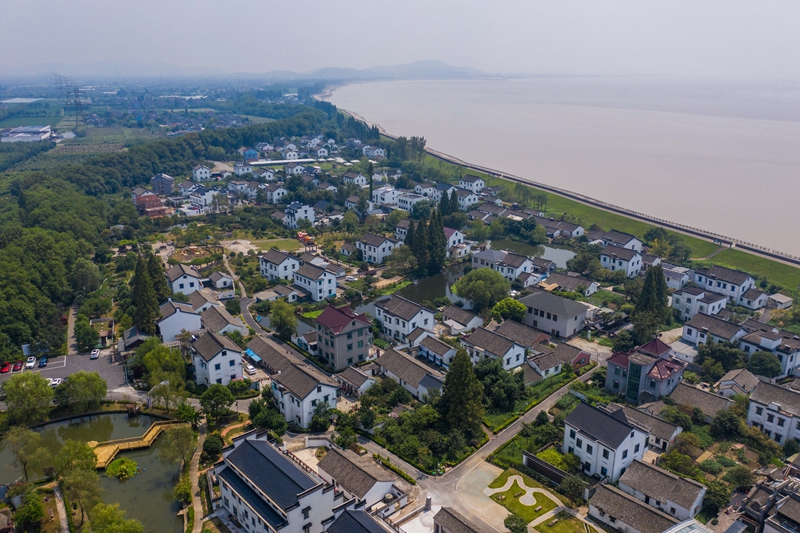"It is not that they are too poor to eat, but rather that they are too old to cook for themselves," Li, a Ph.D. student in rural development and management at China Agricultural University, told Beijing Review. This village has done an even better job, as they not only opened a canteen for these residents to enjoy their meals, but also make sure food gets delivered to the doorsteps of those too weak to eat out.
Such canteens for seniors, offering affordable or even free meals, usually operate in regions with solid financial situations, Li said.
As one of China's most developed areas, Zhejiang's GDP in 2020 reached 6.46 trillion yuan ($1.01 trillion), with per-capita GDP exceeding 100,000 yuan ($15,667). The per-capita disposable income of local residents was 1.63 times that of the national average. The per-capita disposable income of urban residents in the province has ranked first among provincial-level regions for 20 consecutive years, and 36 consecutive years for rural residents.
"The province has laid the firm groundwork for rural elderly care as well as rural governance and development," Li added.
The Communist Party of China (CPC) Central Committee and the State Council jointly published a guideline on June 10 supporting Zhejiang to take the lead in establishing a demonstration zone for the promotion of common prosperity nationwide.
Against this backdrop, Li headed a group conducting a field study of the nine villages located in Kaihua County from October 13 to 29. "We focus on studying how rural governance and collective economy contribute to common prosperity in Zhejiang," Li explained. Rural collectives, making profit on collectively owned resources, have yielded some marked results in narrowing the income gap between urban and rural residents in Zhejiang.

A special canteen for the elderly in Hongguang Village of Chihuai Town in Zhejiang Province's Kaihua County makes and delivers food to those unable to eat at the canteen on October 26 (XINHUA)
Reducing disparities
Jiang Tieying, co-chair of Public Policy Studies at New China Research, a think tank under Xinhua News Agency, told Beijing Review, "China's uneven and inadequate development has become a prominent problem. The excessive income gap has put a severe strain on China's economic and social development as well as on the coordinated development between regions and between urban and rural areas."
"Narrowing the income gap is indeed a major concern that must be addressed in order to achieve common prosperity," Jiang added.
The new guideline called on a narrowing of the income gap between regions, between urban and rural areas, and between individuals, with priority given to improving the incomes of people in rural areas, grassroots units, relatively underdeveloped areas, as well as people living in strained circumstances.
Letting some regions and people get rich first and then gradually pushing for common prosperity is a policy implemented after the launch of the reform and opening-up policy more than 40 years ago. Since then, China has achieved world-renowned economic successes, especially in urban development. However, the development of its rural areas lags far behind that of the cities due to complications including location, resources and the urban-rural dual structure. The latter, a particularly Chinese characteristic, first appeared in the 1950s, but today has become an obstacle hindering the achievement of common prosperity.
As a key indicator of balanced development, the income ratio between urban and rural residents in Zhejiang fell to 1.96:1 last year, lower than the national average of 2.56:1. The province has undertaken many experiments such as the launch of a three-year action plan to eliminate the number of economically weak villages through collective development in 2017, which saw positive outcomes. The Pinghu-Qingtian model was part of the initiative.
Located in Jiaxing City of Zhejiang, and close to the mega city of Shanghai, Pinghu County features an existing industrial base and abundant business resources, yet a lack of land restricts its further expansion. Qingtian County, in another city of Lishui, could provide the land.
A local Pinghu official told Beijing Review that its enterprises have signed agreements with Qingtian's villages culminating in a total initial investment of 195 million yuan ($30.55 million) since 2017. Breaking through land limitations can increase Pinghu's ability to reel in more investment and a larger variety of industries. In the first five years, Qingtian's 156 villages participating in the project stand to make 10 percent of the amount invested; in the second five years, they can earn the land rent and 50 percent of local taxes paid by the enterprises. After a period of 10 years, all parties involved can renegotiate payment shares depending on their development.
The province has seen a large number of such collaborations. Lu Guoming, Secretary of the CPC Puguang Village Branch, in Nanhu District of Jiaxing City, told Beijing Review, "The collective revenue of Puguang mainly stems from collaborative projects across different levels, as well as from the rent of village land and housing."
"We will use the money to improve our daily lives and agricultural infrastructure by investing in road construction, farmland water conservancy facilities and public parks," Lu added. Moreover, villagers are encouraged to work and set up their own business, thus cultivating multiple income-generating models.
More structural improvements entail more opportunities. Following the upgrade in village environment and infrastructure, Lizu Village of Yiwu City, the country's largest wholesale market selling small commodities, transformed itself into a newfangled cultural and creative community that appeals to both investors and tourists alike. Therefore, local residents can operate their own restaurants and homestays to boost income.

A folk art performance in which molten iron is thrown to create fireworks in Wenzhou, Zhejiang Province, on April 30 (XINHUA)
All hands on deck
The cultivation of a collective economy is one of many ways through which Zhejiang has boosted progress in its rural areas en route to common prosperity.
Han Wenxiu, executive deputy head of the Office of the Central Commission for Financial and Economic Affairs, said at a press conference in Beijing on August 26 that China encourages people to work hard in order to become rich. The push for common prosperity allows some people to get rich first and then help others gain more material wealth.
"With its economic accomplishments, Zhejiang also promotes a spirit of mutual assistance and support," Jiang said. Many regions of the province have created a charitable environment with "those who have done better for themselves helping those who still trail behind."
Nanhu District in Jiaxing opened a center to organize social public service activities. "Our center has set up a special fund with an initial amount of 5 million yuan ($782,000) contributed by different organizations, companies and individuals," Xu Lihua, a district official, told Beijing Review.
The center carefully selects and launches social projects, Xu said, and recruits volunteers through online and offline activities.
According to Xu, this year, its volunteers have stepped up for duty 4,510 times, including to assist the elderly in the district and help out families in need.
In the Pinghu-Qingtian model, the spirit of mutual assistance and support has played a substantial role since 2020. Low-income families in both counties could buy shares of the collaborative project. If they could not afford the shares, local individuals or organizations, such as CPC members, banks, enterprises, charities and authorities would help them raise the funds. In Qingtian, 10,600 families with shares earned a total income of 17.2 million yuan ($2.69 million) in the first year.
"The experiences of Zhejiang could be promoted nationwide," Jiang said.
However, as China has vowed to promote common prosperity nationwide, various people came out with their own understandings of the notion, with one interpretation being that creating common prosperity calls for “robbing the rich to pay the poor.”
Han denied any such cliché at a press conference in Beijing on August 26, stating that the objective of common prosperity is not to rob the rich in order to feed the poor. Rather, if a bigger pie of prosperity can be baked, everyone can get a bigger slice of it.
A daunting duty
From a historical perspective, the concept of common prosperity is nothing new, according to Jiang. It is an important goal for the CPC's governance and rejuvenation of the country, and China's leadership has mentioned it at different stages of national development.
Recognizing that common prosperity is an essential requirement of socialism and represents the people's common aspirations, the guideline said this relates not only to economic issues, but also is a political issue that matters to the very foundation of the Party's governance.
"China has eradicated extreme poverty and reached its goal of building a moderately prosperous society," Jiang said. It is now time to clearly define the nation's future goals.
"Of course, it is not an easy task for the country to achieve the next goal," Jiang added. The realization of common prosperity must rely on sustained, steady and high-quality economic development. At this time, the COVID-19 pandemic and China's economic shift from high-speed to high-quality growth could bring about many uncertainties, Jiang explained. These, in turn, could pose obstacles to the course of common prosperity.
Zhejiang is selected to form the demonstration zone because it has achieved remarkable progress in resolving the problem of unbalanced and inadequate development, the guideline read. Additionally, the province also comes with ample space for improvement and brimming potential for further expansion.
By 2025, Zhejiang should already have achieved solid progress in the creation of its demonstration zone, with its per-capita GDP reaching the level of moderately developed economies. Furthermore, the province by that time should present a general olive-shaped social structure in which the middle-income population makes up the majority, the guideline said.
Families with an annual disposable income of 100,000-500,000 yuan ($15,667-78,200) are considered middle-income earners in China. The proportion of the middle-income earners must reach 80 percent, according to the action plan for common prosperity released by the Zhejiang Provincial Government on July 19.
"We hope that Zhejiang can turn these ambitions into reality and, by doing so, inspire other parts of China," Jiang added.

















